Temperature sensor assemblies
Accurate temperature measurement and control of temperature is required for several reasons including safety, material stability, yield optimization and quality; in fact, temperature is the most widely measured value across all processes.
Depending on application either Thermocouples or RTD sensors are normally used for industrial temperature measurement, however other sensor types such as Thermistors, IR sensors and semiconductor devices can also be applicable.
Both Thermocouples and RTD sensors are inherently fragile devices which are susceptible to both mechanical forces and electrical interference.
As industrial control systems rely on stable and accurate input signals that are free from noise and external interference it makes sense that temperature sensors must be protected from external forces present at the measuring point, such as pressure or vibration.
Typically, temperature sensors will be protected by inserting the fragile sensor element into a protective sheath and packing with a ceramic powder. This protects the sensor from vibrations and potentially aggressive process media which would damage the element.
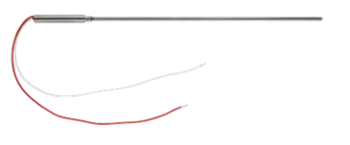 |
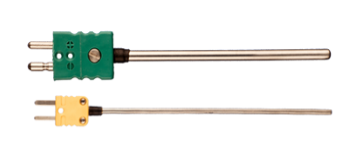 |
| Pt100 sensor with stainless steel sheath and flying leads | Thermocouple sensors with stainless steel sheath and plug connections |
To complete a temperature assembly a connection head would typically be attached to the sensor. This allows for connection of the sensor wires to either a terminal block or temperature transmitter. Various head types are available depending on the application and whether the temperature sensor assembly is located in a hazardous area. If a temperature transmitter is fitted it must also be ATEX certified if it is installed in a hazardous area.

Selection of standard head types
Courtesy: www.kp-as.com
To make sensors suitable for use in industrial process control they require specific materials of construction, process connections and dimensions specific to individual applications. A wide selection of industry standard sensor assemblies are available which can be customized to the exact process demands.
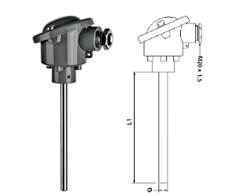 |
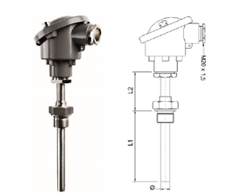 |
 |
| Temperature sensor with connection head for transmitter | Temperature sensor including threaded process connection | Temperature sensor for food industry |
| Courtesy: www.kp-as.com |
A “head mount” temperature transmitter is often fitted inside the connection head. The transmitter amplifies the low-level sensor signal and ensures an accurate, stable signal is made available to the control system. Isolated temperature transmitters are recommended as they further improve the signal quality by filtering noise and electromagnetic interference.
Additional advantages of using a temperature transmitter include the ability to linearize the signal and the option to include a local display such as in the 7501 field mounted transmitter.
Alternatively, a terminal block may be fitted to the connection head and the sensor signal sent to a DIN rail mounted temperature transmitter. In this case careful consideration must be given to induced interference and degradation of the sensor signal. This is often seen with extended cable lengths between the sensor and temperature transmitter.
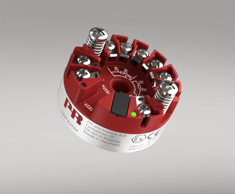 |
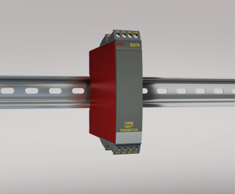 |
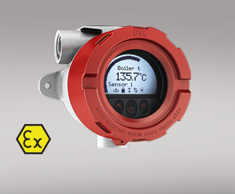 |
| PR 5437A Head mount 2-wire HART 7 temperature transmitter | PR 6337A DIN rail 2-wire HART temperature transmitter | PR 7501 Field mounted HART temperature transmitter |
Transmitters are also available which support easy integration into fieldbus and digital schemes such as HART, Foundation Fieldbus, Profibus and IO link. PR 5350 head mounted transmitter and PR 6350 DIN mounted transmitters support both Foundation Fieldbus and Profibus PA in the same device, whilst the PR 5335, 5337, 5437, 6335, 6337 and 6437 are HART temperature transmitters.
Although these sensor assemblies can be used directly, industrial applications often require the temperature sensor to be easily replaceable, be inserted in difficult to access locations, or exposed to pressures and flow rates which may cause damage.
Storage tanks and pipelines for example require a temperature sensor to be replaced easily without process material escaping or a need to drain the system. This issue is overcome using Thermowells or Thermo pockets.
Thermowells are used to protect temperature sensors against damage from excessive pressure, high flow rates and corrosive effects. In addition, they allow sensor replacement without draining the system or process. Thermowells designed for high pressure applications are typically machined from bar stock to ensure integrity. Thermowells for use in low pressure environments may be fabricated from tubing with one end welded closed. The thermowell is normally secured to the process either by a threaded connection of by welding. The temperature sensor is then inserted into the thermowell and secured.
Depending on the application, the thermowell must be specified so that it will meet the technical demands of the process.
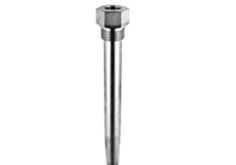 |
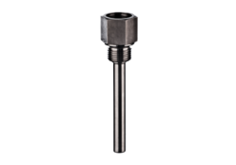 |
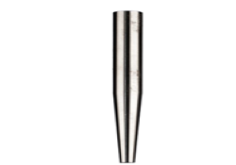 |
| Barstock thermowell with threaded process connection | Fabricated thermowell with threaded process connection | Barstock weld in thermowell |
| Courtesy: www.kp-as.com |
Find more information about PR electronics range of temperature transmitters and signal conditioning products here.



